Even the most practical person cannot help but be captivated when night falls upon the earth, bringing with it a serene and star-filled sky. The map of constellations in the northern hemisphere showcases several intricate celestial formations. However, their true magnificence can only be fully appreciated by gazing up at the sky on a night like this. The Big and Little Dippers, Wolopassus, Cassiopeia, Cepheus, and others have a mesmerizing effect, causing one to pause in awe and admire the boundless beauty of the cosmos, all visible to the naked eye.
Today, our focus is on the constellation Cepheus (pictured below). While it may not be the brightest or most impressive, it is still deserving of thorough exploration and study.
Where is it located?
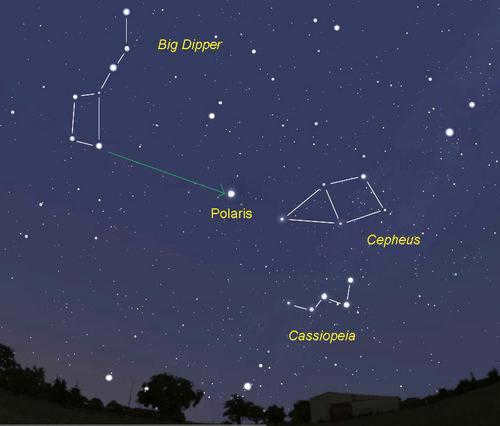
Cepheus is situated adjacent to the constellations Ursa Minor and Cassiopeia in the night sky. Locating constellations similar to Cepheus is typically quite effortless: the stars forming these celestial patterns are rather luminous and conspicuous. However, the most notable guidepost to seek out is the group of stars known as the Northern Cross, positioned to the south of Cepheus within the constellation Cygnus.
In the entire expanse of our nation, Cepheus does not dip below the horizon. The most optimal period for observing it is from July to September. A portion of the constellation lies along the path of the Milky Way.
Proximity to the North Pole
The constellation Cepheus, which consists of approximately 150 stars, can be easily observed without any equipment on clear nights. Its shape resembles an irregular pentagon. Interestingly, the closest neighbor of Cepheus, the Little Bear constellation, will not always include the North Star. Due to precession, the position of today’s Polaris will eventually be occupied by stars from the Cepheus constellation, such as Alfirk (beta), Alrai (gamma), and Alderamin (alpha). Around 3100, Alfirk will take the place of honor. These stars, along with Cepheus’ zeta and iota, form the distinctive pattern in the sky.
According to scientists, the group of celestial figures in question emerged simultaneously with the nearby constellations of Cassiopeia, Perseus, Pegasus, and Andromeda. Legends surrounding these constellations also suggest a shared origin. This leads one to contemplate the potential wisdom of ancient civilizations.
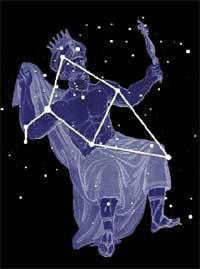
In Greek mythology, Cepheus was known as the ruler of Ethiopia. He was renowned for his wealth and many virtues, but he was most famous for his wife Cassiopeia and daughter Andromeda, who were known for their exceptional beauty. According to one version of the myth, Queen Cassiopeia was a stubborn and headstrong woman. She made the mistake of comparing her daughter’s beauty to that of the flawless gods of Olympus, which angered them and led to their desire to punish both women.
Another account suggests that the envious deities did not need to wait for Cassiopeia’s thoughtless remarks: they personally observed Andromeda’s resplendent beauty and resolved to terminate such insolence. Regardless, an immense Whale materialized off the shores of Ethiopia, venturing onto the land each day and consuming the inhabitants of the land. Cepheus endeavored to rescue the kingdom. The whale consented to spare the villages from devastation, on the condition that he would be presented with the most exquisite maiden each day.
A remarkable save

Andromeda’s turn eventually came, bringing both sorrow to her parents and excitement among the jealous gods. They bound the girl to a rock, where the approaching whale threatened her life. However, in a sudden twist, Perseus swooped in on the back of Pegasus and rescued the king’s daughter.
The beast was vanquished and the maiden was saved, resulting in the transformation of each hero into a constellation: Cepheus, Cassiopeia, Andromeda, Perseus, Pegasus, and even the Whale.
Unflashy, yet significant
All of the mentioned celestial entities are situated in close proximity to one another in the celestial sphere. The constellation Cepheus, resembling its majestic counterpart, falls short of Cassiopeia in terms of aesthetics. Nevertheless, both the ancient ruler and his celestial depiction have ample reasons to be proud. The stars comprising Cepheus possess a distinct allure for scientists, encompassing binary systems, massive luminaries even by cosmic standards, and a star that has bestowed its name upon an entire category of comparable cosmic entities.
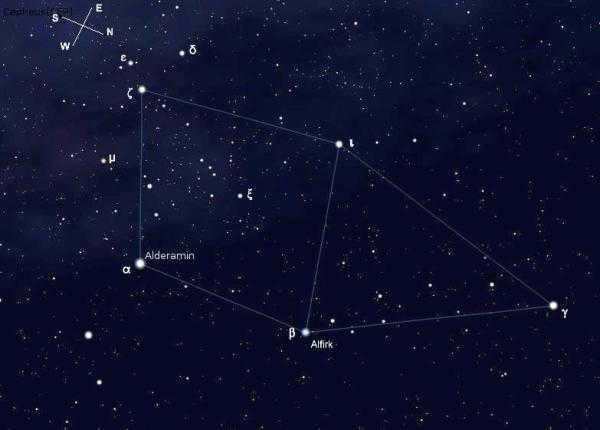
A Pair of Cows
Among the many stars in the constellation Cepheus, there is one that shines the brightest – Alderamin (alpha). Its name translates to “right hand” and it is situated at the elbow of the regal figure. With a stellar magnitude of 2.45, Alderamin is a white subgiant of the spectral class A. What sets this star apart is its incredibly rapid rotation. It completes a full revolution in just 12 hours, whereas the Sun, for instance, takes about a month to perform the same feat. Scientists estimate that Alderamin is approximately 49 light-years away from us. Current data suggests that Alpha Cepheus is currently undergoing a transformation into a red giant.
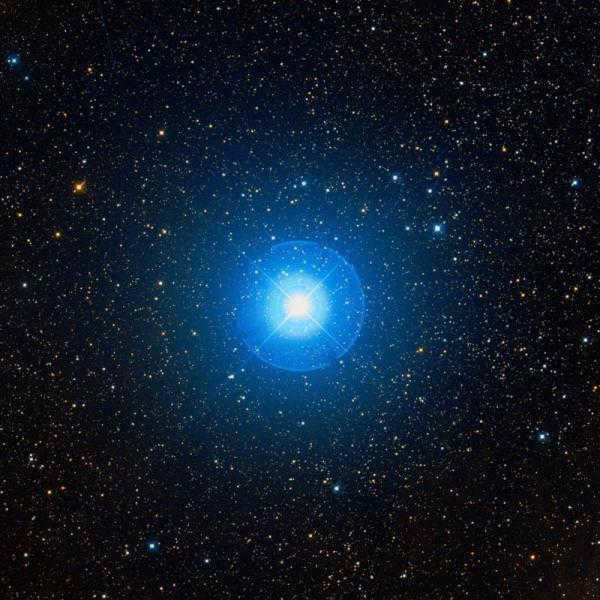
Beta Cepheus, also known as Alfirk, is a variable star that belongs to a distinct class of celestial bodies. The Beta Cepheus stars exhibit a variation in brightness ranging from 0.01 to 0.3 stellar magnitude. In the case of Alfirk, its brightness ranges from +3.15 to +3.21. This variation occurs over a period of 0.19 days.
In ancient times, Arab astronomers grouped Alderamin and Alfirk together to form the asterism known as “Two Cows”. Another star, gamma Cepheus, was associated with this asterism and given the name Alrai, meaning “shepherd”.
Dual System
The Cepheus constellation contains multiple stellar “coalitions”. Alrai is particularly intriguing as it is the first binary system in which an exoplanet was found. Gamma Cepheus A is an orange subgiant, with a mass 1.6 times that of the Sun and a luminosity 8.2 times greater. It is accompanied by a red dwarf in its orbit. The revolution period for Cepheus B is approximately 74 years. The Alrai system is located 45 light years away from our Sun.
Gamma Cepheus A is home to an exoplanet, which was initially theorized in 1988 and later confirmed in 2003. This planet completes one orbit around its star in approximately 2.5 years. Its mass is estimated to be 1.59 times that of Jupiter.
Delta
Another binary system in the Cepheus constellation is Alredif, also known as Delta Cepheus. However, its components are not well-documented. Alredif is the primary star that is part of the class of variable stars known as Cepheids.
Delta Cepheus exhibits changes in its luminosity over a period of approximately five days. Interestingly, the increase in brightness occurs more rapidly than the decrease. What sets this star apart is that the change in luminosity is accompanied by changes in other characteristics, such as its spectral class. During minimum luminosity, Delta Cepheus is classified as a type G2 star, similar to our Sun, while at maximum luminosity, it is classified as F5. These unique features of the star remained unexplained for some time.
The clue, however, has been discovered. It has been determined that the star undergoes pulsation, meaning it alters its size. On average, the diameter of Cepheus Delta is equivalent to 40 times the diameter of our own sun. Throughout the pulsation, it fluctuates by 4 corresponding measures, which equates to several million kilometers. During the compression phase, the surface of Alredif heats up, resulting in an increase in its brightness. Conversely, during expansion, some cooling occurs and the luminosity decreases. These types of changes are typical for the entire Cepheid class.
The constellation Cepheus is renowned for its three enormous stars, which are among the largest objects in the entire Universe. These stars are classified as red supergiants. One of them, known as mu Cepheus, is particularly noteworthy. It has a total luminosity that is 350,000 times greater than that of the Sun. The star is also commonly referred to as Herschel’s Garnet Star, named after the astronomer William Herschel, who was the first to observe its stunning red hue. In terms of magnitude, mu Cepheus is an impressive 1650 times larger than the Sun. However, there is some debate among scientists regarding the exact distance between this red supergiant and our own star. The most recent and accurate estimate places it at approximately 5200 light years away. Currently, mu Cepheus is in the final stages of its life cycle. Within the next several million years, it is expected to undergo a massive explosion, resulting in the formation of a black hole from its collapsed core.
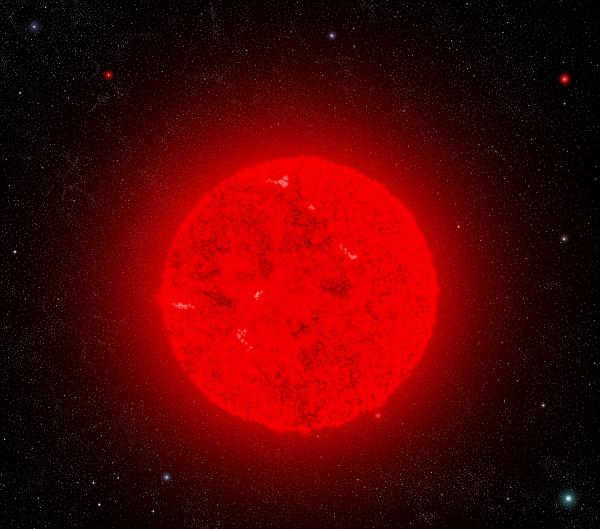
Mu Cepheus is an example of a triple star system. Its main pair consists of the less impressive B and C components.
Another red giant in the constellation is VV Cepheus, a double eclipsing star located 5,000 light-years away from the Sun. The A component of this system is a massive luminary, ranking as the third largest known luminary and the second largest in the Milky Way galaxy. It has a diameter of over 2.5 billion kilometers, which is approximately 1700 times larger than the Sun. VV Cepheus A shines brighter than our own star by a factor of 275-575 thousand. The second component of the system orbits the first with a period of 20 years and is 10 times the size of the Sun.
The third red supergiant in question is HR 8164. It does not possess a unique name for its luminosity. Its stellar magnitude is estimated to be around 5.6.
Proximity to Earth
All of the objects that have been given names are situated at a respectable distance from the planet Earth. However, Cepheus also possesses a particular star that is a mere 13 light-years away. This star is known as Kruger 60 and it is actually a binary star system consisting of two red dwarfs, which are significantly smaller in size compared to the Sun. Kruger 60 A, the first component, is nearly four times smaller in terms of mass and its radius is only 35% of the radius of the Sun. On the other hand, Kruger 60 B is even more modest as its mass is about 5.5 times less than that of our Sun. In terms of diameter, Kruger 60 B is only 24% of the corresponding parameter of the Sun. The second companion of Kruger 60 is known for its flaring behavior, where its luminosity doubles every eight minutes and then returns to its original value. Both components of the system orbit around a single center of mass with a period of 44.6 years.
The constellation Cepheus is home to not only fascinating stars but also stunning nebulae. One of these nebulae, NGC 6946, is particularly captivating as it resembles a breathtaking firework display. What makes NGC 6946 even more intriguing is the fact that nine supernovae stars have already been discovered within its boundaries, a number unmatched by any other nebula. This celestial firework can be found on the border of the Cepheus constellation and the Swan constellation.
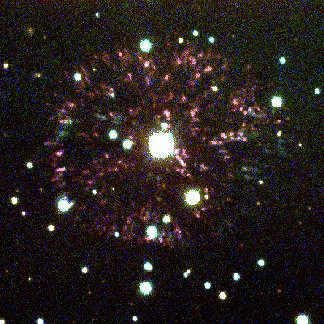
There is another celestial structure connected to Cepheus that shares some similarities. IC 1396 is a nebula that emits light and is well-known for containing the Elephant Trunk, a mass of dark interstellar dust. This particular formation earned its name due to its striking resemblance to a specific section of a gigantic creature.
A dispersed gathering
The celestial arrangement Cepheus maintains within its “territory” one of the most ancient formations in the universe that has been discovered thus far. This particular formation is a dispersed gathering known as NGC 188, which consists of 120 stars that were all formed around the same time from a shared molecular cloud. NGC 188 was initially identified by Herschel in 1831. The initial estimation of the cluster’s age calculated its existence to be approximately 24 billion years. However, subsequent calculations have revised this figure. Presently, it is widely accepted that NGC 188 is 5 billion years old.
The beauty of celestial drawings cannot be fully grasped through descriptions of constellations, no matter how detailed they may be. Even with precise coordinates and descriptions of star characteristics, one cannot truly feel the infinite nature of the Universe until they gaze upon the night sky themselves. While myths about constellations offer some insight into the connection between the earthly and cosmic realms, they cannot replace firsthand observation. However, information about the objects that make up these celestial patterns can provide a deeper understanding of even the seemingly ordinary stars. A prime example of this is the constellation Cepheus, which may not be the most prominent, but harbors many intriguing elements that pique the curiosity of those who study them.
In the second century, Ptolemy listed it among the constellations in the Cepheus group. Within this constellation, you can find Mu Cepheus, one of the most renowned stars in the Milky Way, along with other celestial objects including NGC 7380 and Iris nebulae, as well as the Fireworks Galaxy.

Interesting Information, Location, and Stellar Chart
The constellation Cepheus covers an area of 588 square degrees, making it the 27th largest constellation in the night sky. Positioned in the fourth quadrant of the northern hemisphere (NQ4), it can be observed at latitudes ranging from +90° to -10°. Cepheus shares its boundaries with the constellations Giraffe, Dragon, Cassiopeia, Lizard, Little Bear, and Swan.
This celestial region is home to a single star system that hosts planets, but does not contain any Messier objects. The brightest star in Cepheus is known as Aldemarin. Additionally, there are no known meteor streams associated with this constellation. Cepheus is part of the Perseus group, which also includes Andromeda, Cassiopeia, Lizard, Pegasus, Perseus, Whale, Ascendant, and Triangle. To explore the detailed arrangement of stars within the constellation Cepheus, refer to the accompanying star map.
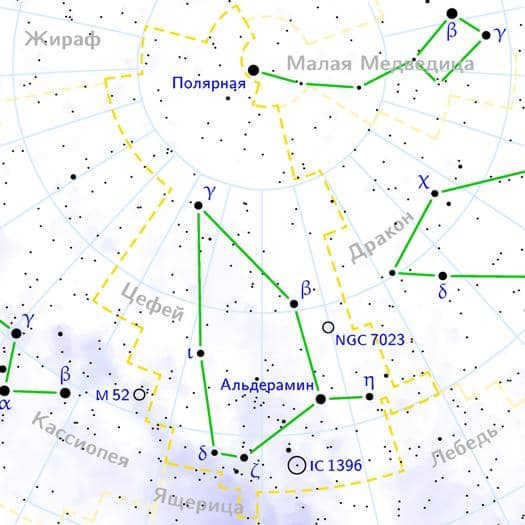
Legend
Once upon a time, there was a great ruler named King Cepheus from the land of Ethiopia. He was married to the stunning yet arrogant Cassiopeia. One day, Cassiopeia claimed that she was more beautiful than any of the nerids, a group of nymphs. This boast offended the nerids, and they sought revenge by seeking the help of Poseidon, the god of the sea. Poseidon decided to punish the kingdom by sending a fearsome sea monster named Cetus to wreak havoc.
Desperate for a solution, King Cepheus consulted the Oracle, who advised him to sacrifice his beloved daughter, Andromeda. Despite his sadness, the king followed the Oracle’s advice. However, just as Andromeda was about to be devoured by Cetus, a brave hero named Perseus appeared and saved her in the nick of time. Grateful for her rescue, Andromeda and Perseus fell in love and decided to get married.
Unfortunately, their wedding was interrupted by the arrival of Phineas, who also claimed Andromeda’s hand in marriage. A fierce battle broke out between Perseus and Phineas, but Perseus was outnumbered. In a desperate move, he revealed the head of Medusa Gorgon, a monstrous creature whose gaze turned people to stone. Cepheus and Cassiopeia, unable to avert their eyes from the terrifying sight, were transformed into stone statues.
Prominent celestial bodies
Delve into the radiant celestial bodies of the constellation Cepheus in the northern hemisphere, accompanied by comprehensive explanations and characterizations.
Alderamin (Alpha Cephei) – holds the highest position in terms of luminosity within the constellation. This star is a class A white star that undergoes a transformation from a main-sequence star to a subgiant. It is located 49 light-years away. Its name is derived from the Arabic phrase að-ðirā 'al-yamīn, which translates to “right hand”. The visible magnitude of Alderamin is 2.5141. It rotates at a speed of 246 km/s and completes a revolution in 12 hours or less.
This star remains above the horizon when observed from Europe, North Asia, Canada, and most cities in North America. It can be easily located without the need for any technological assistance.
Alfirk (Beta Cepheus) is a triple star system with a magnitude ranging from 3.15 to 3.21 that varies over a period of 0.1904844 days. It is situated at a distance of 690 light-years.
The term “flock” is derived from the Arabic al-firqah. It serves as a model for a group of stars known as Beta Cepheus variables. These stars are in the main-sequence phase and have masses ranging from 7 to 20 times that of the Sun. Their brightness fluctuates due to surface pulsations, typically varying by 0.01 to 0.3 magnitudes with periods lasting from 0.1 to 0.6 days.
The primary component of Alphyrk A is a blue giant star classified as B2IIIev. The suffix “ev” indicates that its spectral radiation exhibits variability. It completes one revolution every 51 days, traveling at a speed of 28 km/s.
Delta Cepheus is a binary star system with an apparent visual magnitude that ranges from 3.48 to 4.37. It is located 891 light-years away. This star system serves as a prototype for the Cepheid-type variables, a class of stars. Polaris, also known as the North Star or the Pole Star, is the closest Cepheid-type variable to our solar system.
Cepheids typically have masses 3-30 times that of the sun and go through a main-sequence stage as B-class stars. Afterward, they begin to burn fuel and their core starts to contract and expand.
Cepheids are dying stars with massive sizes. Their brightness makes them easily detectable without the need for technology. The luminosity of a cepheid is directly related to the periodicity of its pulsation, allowing astronomers to determine its distance and location by measuring its visual magnitude.
The average Delta magnitude of Cepheids is 4.07.
Alrai (Gamma Cephei) is a binary star located in the constellation Cepheus. It consists of an orange subgiant (K1III-IV) with an age of 6.6 billion years. Alrai can be observed with the naked eye. The secondary star has a mass of approximately 0.409 times that of the sun and belongs to the M4 class of red dwarfs.
Its apparent magnitude is 3.22 and it is situated 45 light years away. The term originates from the Arabic ar-rā'ī, meaning “shepherd”. In 1989, astronomers discovered an exoplanet orbiting the brighter star. Later on, they admitted their mistake, but in 2002 they found new evidence supporting its existence.
In the future, during the 3000s, Gamma Cephea will take the place of Polaris due to the phenomenon of equinoxes.
Zeta Cephea is classified as an orange subgiant with a spectral type of K1 IV. Its magnitude measures 3.39 and it is located 730 light years away. Situated in the left shoulder of the Cepheus constellation, it is 8 times more massive than the Sun and 3600 times brighter. Its surface temperature is 4,310 Kelvin. Additionally, it is believed to be a binary star and a variable star.
This particular Cepheus is a giant star that emits a vibrant orange color. Its spectral type is categorized as K0 and it is located approximately 45 light years away from us. What makes this star unique is its significant proper motion. In traditional contexts, it is commonly referred to as Al-Kidr.
Mu Cepheus, on the other hand, is a supergiant star that radiates a striking red hue. Its distance from us is estimated to be around 2400 light years, although this value is not entirely certain due to its remote location. This star falls under the spectral class M2Ia.
Among the most renowned luminous stars, this particular one is sometimes called Herschel’s Garnet Star due to its intense red color. The star’s appearance was described by Herschel as “garnet-colored, similar to Keith’s periodic star.”
As a bright M-type supergiant, it stands as one of the largest stars ever observed within our entire galaxy. In terms of size, its radius is an astonishing 1650 times that of the Sun, equivalent to 7.7 astronomical units. If it were not obstructed by interstellar dust, its magnitude would be 1.97. However, due to this dust, its magnitude fluctuates between 3.62 and 5 over a period of approximately 2 to 2.5 years.
The star is nearing its end. It is unstable and will soon undergo a massive explosion known as a supernova (in a few million years).
HD 208816 is a binary star system with a radius of 7.5-8.8 astronomical units. It is located 2400 light-years away and has a visible brightness of 4.91. The system consists of a red hypergiant star and a blue companion star. The red hypergiant is the third largest star known, with a size of 1,600-1,900 times the radius of our Sun.
V381 Cepheus is a red supergiant star with a visible brightness of 5.66 and a distance of 3.663 light-years. It is classified as a pulsating variable star of spectral class M1lbpe+. It has a mass of approximately 9-10 times that of our Sun.
Kruger 60 is a binary star system consisting of two red dwarf stars that orbit each other with a period of 44.6 years. The system is located 13.15 light-years (4.03 parsecs) away from us and has apparent magnitudes of 9.59 and 11.40. In 88,600 years, it will come closer to our solar system, reducing its distance to 1.95 parsecs.
Celestial bodies
The NGC 6946, also known as the Fireworks Galaxy, Arp 29, or Caldwell 12, is a type of intermediate spiral galaxy located in the constellation of Cepheus. It is situated approximately 22 million light-years away from Earth and has an apparent magnitude of 9.6. This fascinating celestial object can be found in the region between the constellations of Cepheus and Swan.
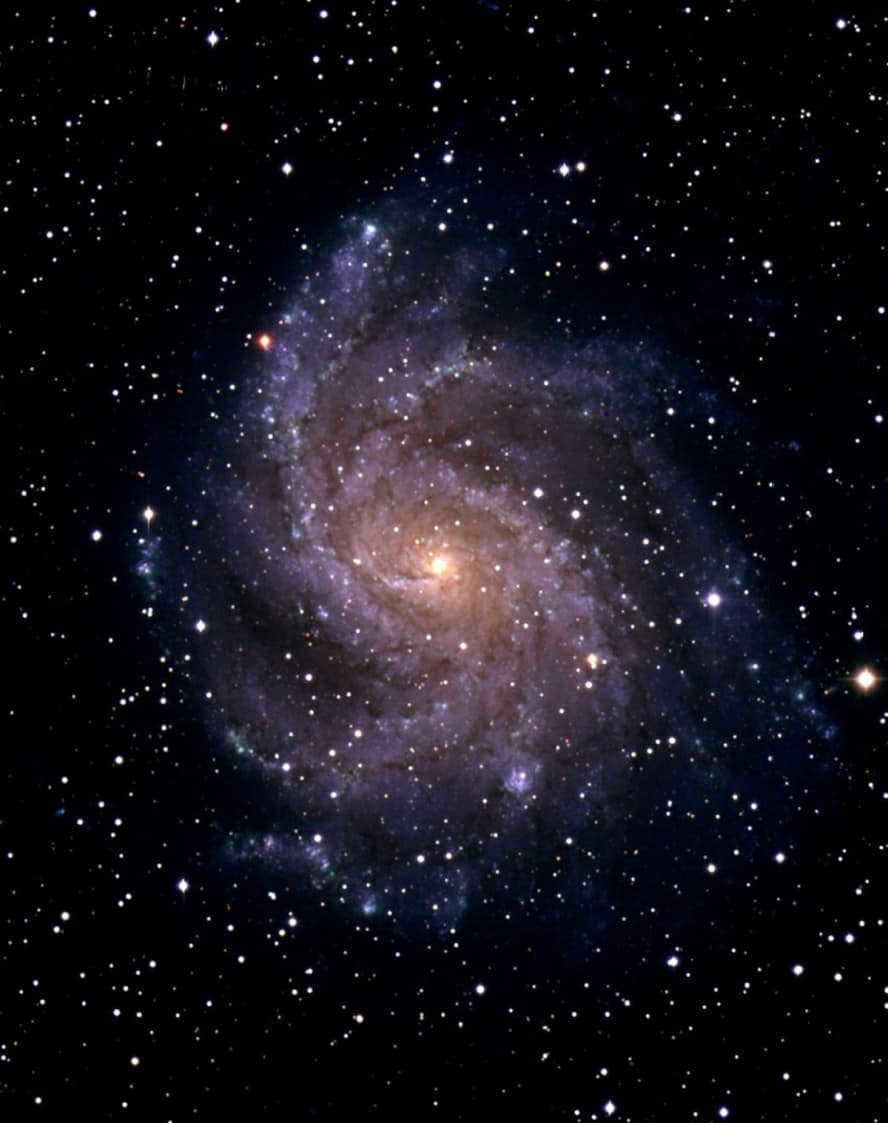
The Fireworks Galaxy, also known as NGC 6946, was first observed by William Herschel in September 1798. Throughout the past century, astronomers have discovered a total of 9 supernovae within this galaxy: SN 1917A, SN 1939C, SN 1948B, SN 1968D, SN 1969P, SN 1980K, SN 2002hh, SN 2004et, and SN 2008s.
NGC 7380, commonly referred to as the Wizard Nebula, is an open star cluster that was initially identified by Caroline Herschel in 1787. This star cluster is part of a larger nebula with a diameter of approximately 110 light-years.
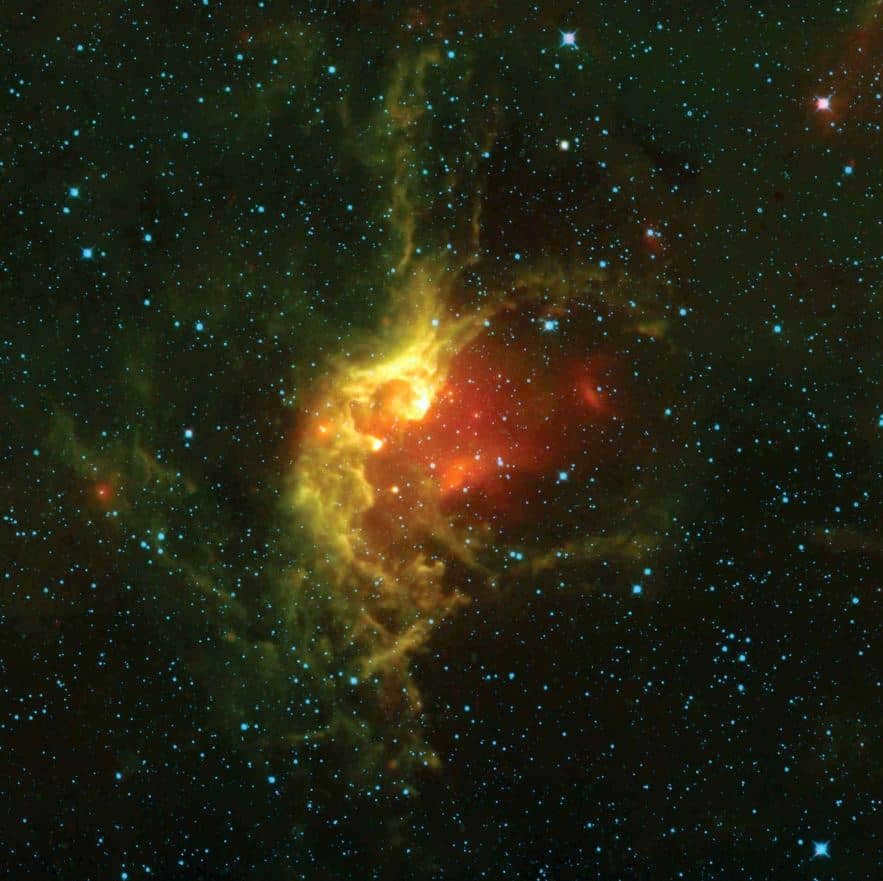
The cluster is situated at a distance of 7,000 light-years from our planetary system. The stars within it are no more than 5 million years old, indicating that we are observing a relatively young and open cluster.
NGC 7538 is a nebula that exhibits both emission and reflection properties, and it is located approximately 9,100 light-years away. Within this nebula, there exists the largest protostar known to us, which is formed when gas condenses within a massive molecular cloud. In comparison, the size of this protostar in the Perseus Arm is approximately 300 times that of our Solar System.
Discovered in 1825 by William Herschel, NGC 188 (also known as Caldwell 1) is a star cluster that can be found at a distance of 5,400 light-years away. This cluster holds the distinction of being one of the oldest known star clusters, and it is positioned 5 degrees away from the North Celestial Pole.
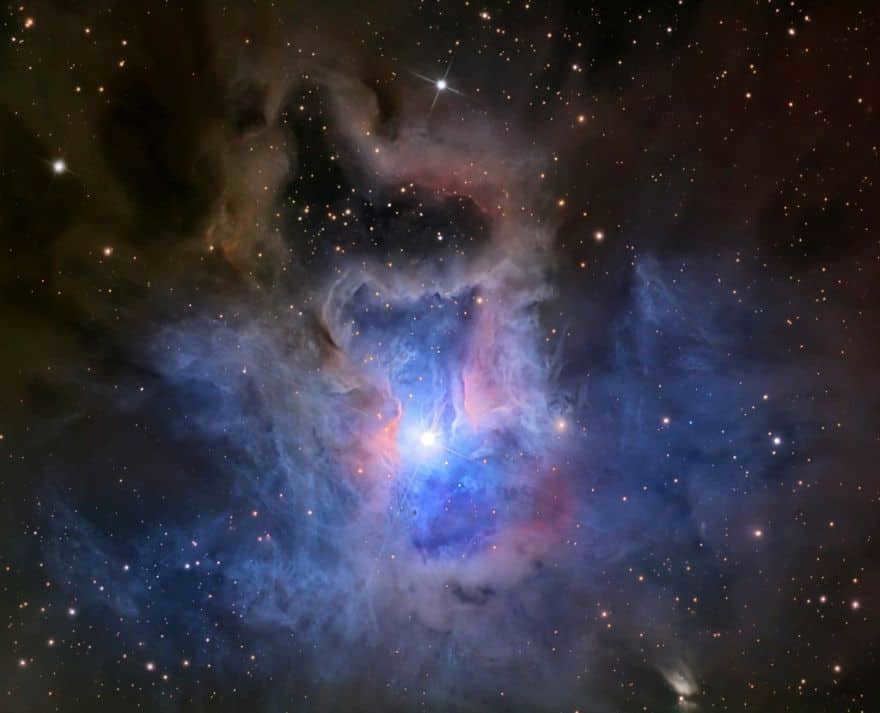
The star SAO 19158 provides illumination for it, and it is in close proximity to two relatively bright stars, T Cepheus (a variable star of the Mira type) and Beta Cepheus (with an apparent magnitude of 3.23).
NGC 7129 is a region where stars are currently being formed, situated within a nebula that has a shape reminiscent of a rosebud.
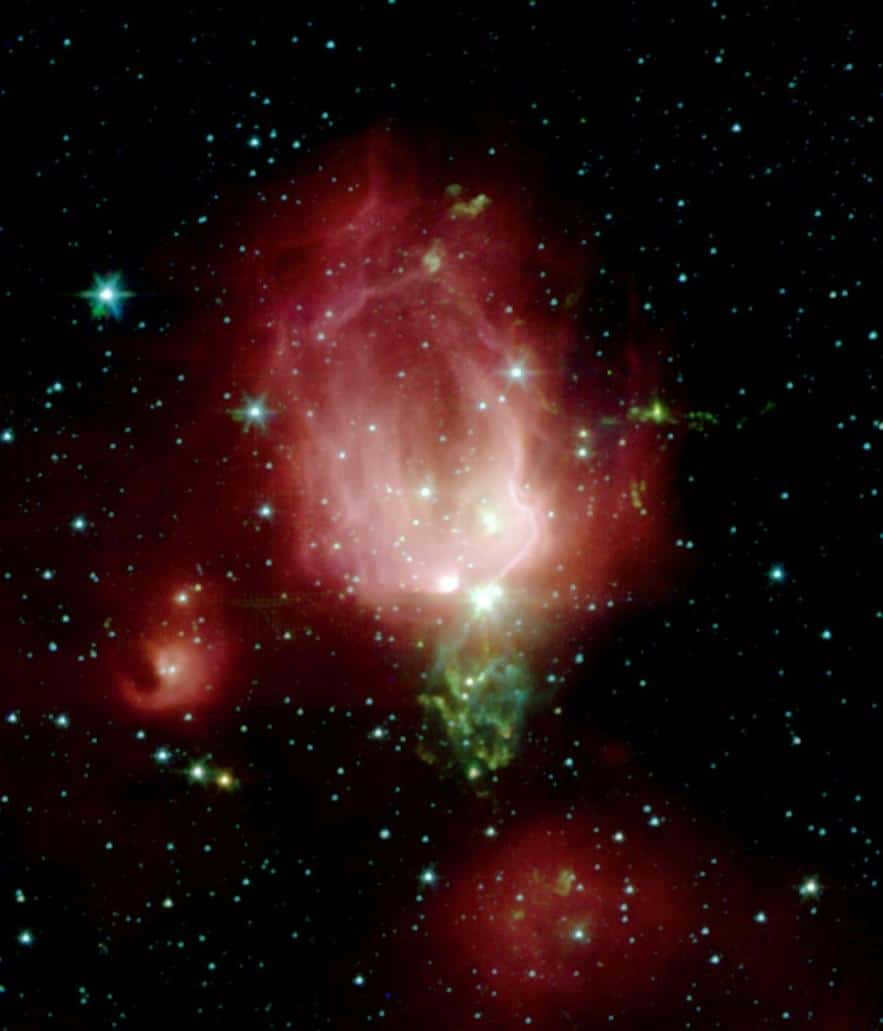
NGC 7129 is a cluster that consists of 130 young stars that are less than a million years old. It is located 3,300 light-years away and has a brightness level of 11.5.
Another cluster, NGC 7142, is an open cluster with a brightness level of 9.3 and is situated 6,200 light-years away. It is found near the NGC 7129 nebula and is partially hidden by an interstellar cloud.
Despite being one of the oldest clusters, the exact age of NGC 7142 is difficult to determine due to the presence of interstellar reddening. Interestingly, this cluster contains a significant number of young blue stars.
If you want to explore the constellation Cepheus in more detail, you can use our photos, as well as 3D models and online telescopes. Alternatively, you can use a star map for independent observation.

Indeed, the configuration of the Cepheus constellation bears a resemblance to an irregular pentagon. It covers an expansive area of 587.8 square degrees, making it the 27th largest constellation in the celestial sphere. Additionally, a portion of its territory can be found within the Milky Way galaxy.
As a rightful member of the stellar regions in the Northern Hemisphere, the Cepheus constellation shares its borders with other well-known celestial figures in this part of the sky. These include Cassiopeia, Ursa Minor, Draco, Cygnus, and various others.
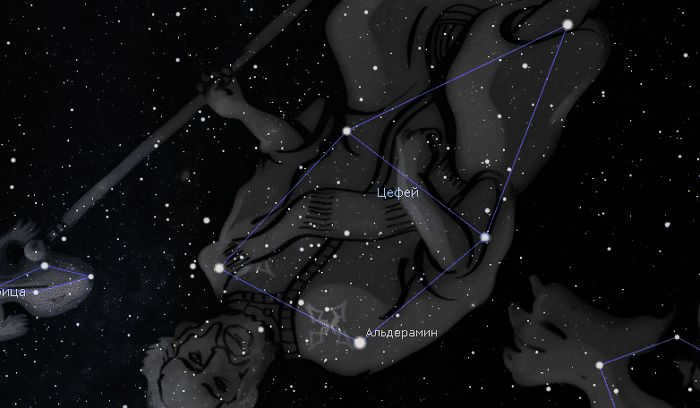
Moreover, the Cepheus constellation is situated in close proximity to the Polaris star. This particular circumstance undoubtedly has an impact on its detection and excellent visibility.
Interestingly, it has been discovered that the pole of the world is gradually moving in the direction of Cepheus. This phenomenon is attributed to the Earth’s axis experiencing precession. According to scientific predictions, the Gamma star within the constellation itself will assume the role of Polaris by the year 3100.
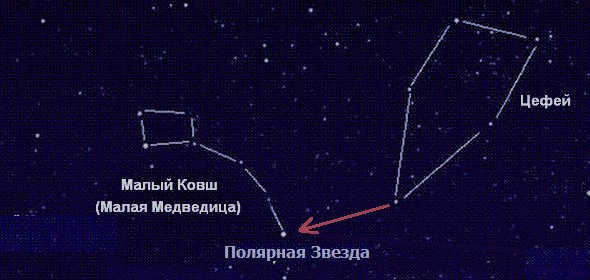
The Mythical Tale of Cepheus Constellation
In ancient Greek mythology, there existed a monarch known as Cepheus. Within his realm, he had a remarkably beautiful spouse named Cassiopeia. Filled with pride, Cassiopeia believed herself to be more exquisite than the Nereids, who were the offspring of Nereus, the river god. Upon discovering this, the Nereids felt deeply insulted and sought retribution from Poseidon, the god of the seas. Consequently, Poseidon dispatched a terrifying monster to Cepheus’ kingdom. The outcome of this legend can be discovered here.
According to folklore, the goddess Athena transformed Cepheus into a constellation. As such, it is widely believed that this constellation represents the ancient Greek ruler.
Actually, there are no bright stars present. Out of the entire constellation, the most notable one is Alpha – Alderamine.
Beta — Alfirk is a star that varies in brightness. Interestingly, this particular celestial body served as the prototype for a group of similar stars. We refer to them as Cepheids. It turns out that they have the ability to pulsate with a precise period dependence.
Furthermore, this region contains three red supergiants. They are visible even to the naked eye.
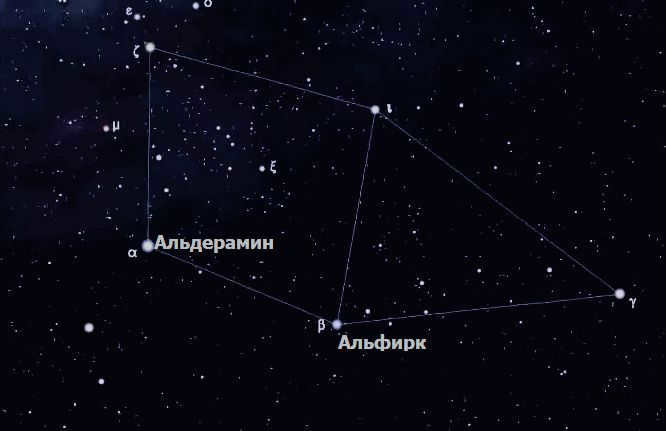
An enormous threesome:
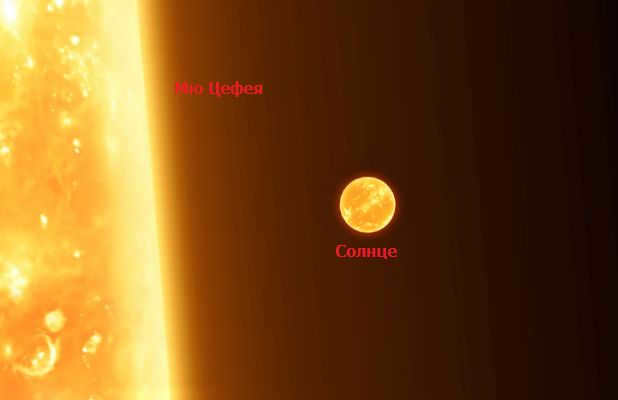
- Mu or, as it is sometimes called, Herschel’s crimson star (reportedly named after the discoverer), is considered one of the most massive and powerful celestial objects in the Milky Way.
- VV Cephei in Cepheus is characterized by being a binary system.
- Krueger 60 in Cepheus is also a binary star.
Additional Items
In addition to the stars, the constellation Cepheus contains a number of intriguing objects.
One such object is the NGC 6951 spiral galaxy, which is located within Cepheus. Despite its relatively small size, it is a remarkably stunning entity. Furthermore, it is a highly dynamic star system.
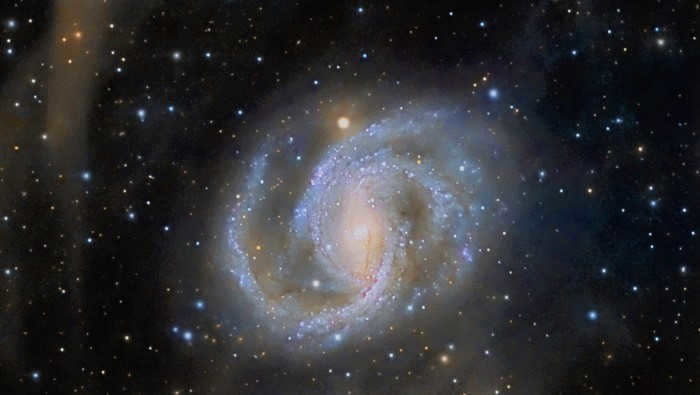
Dispersed stellar clusters:
- NGC 188 is a group of stars and it is considered one of the oldest dispersed clusters in the Galaxy. Scientists estimate its age to be around 5 billion years.
- NGC 6939 is a stunning concentration of stars situated between Cepheus, Swan, and Dragon.
- NGC 7142 is known for its abundance of faint and ancient stars, as well as hot supergiants. Interestingly, the nearby nebulae include the Little Cluster nebulae and the Cosmic Rose. Additionally, this region is characterized by the rapid formation of new stars.
- NGC 7160 consists of eight bright stars that create a bucket-like shape. Some people even see a dolphin in this configuration, as their imagination suggests.
- NGC 7226 is a small and inconspicuous cluster in the night sky. Its size is relatively small.
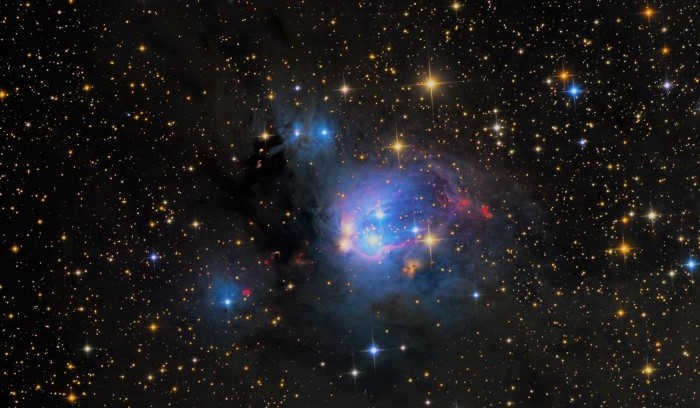
- NGC 7235 doesn’t attract much attention except for its prominent blue star. It is a binary system that exhibits variability and pulsation.
- NGC 7261 is located in the western part of the constellation. Although it remains hidden from human observation, it contains nearly 100 stars.
- NGC 7380 is often referred to as an emission nebula. In the realm of modern astronomy, it has earned the nickname “the Harry Potter and the Golden Snitch Nebula”. Its shape is reminiscent of the famous wizard and his magical ball.
- NGC 7510 can be found in the Cassiopeia region. Scientists estimate that this cluster is composed of approximately 80 stars, which are arranged in a chaotic manner.
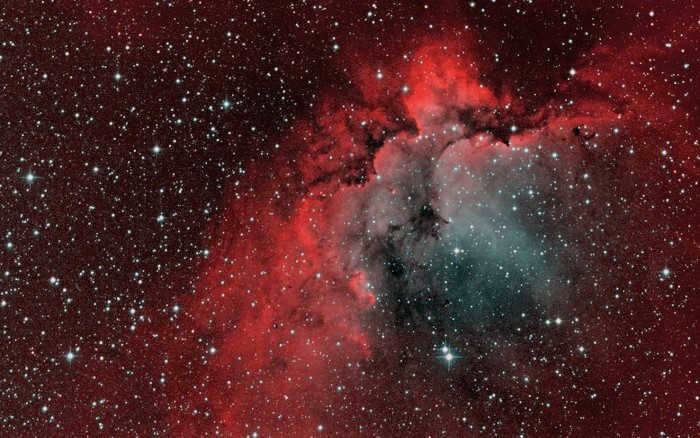

Nebulae
The celestial region known as IC 1396 is an emission nebula and is currently undergoing active star formation. What makes this area intriguing is the fact that it is referred to by various names, including the Elephant’s Trunk.
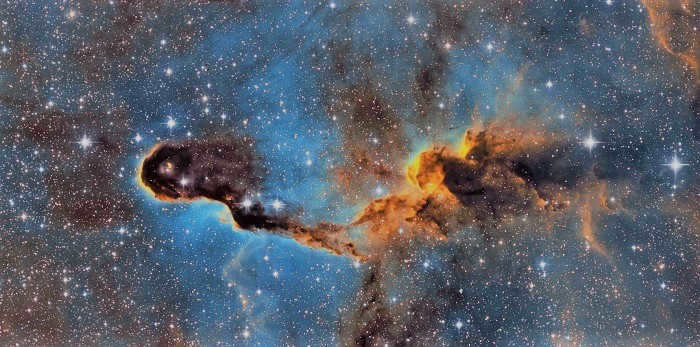
The cave or Grotto is known for its impressive size. Although it has a low stellar magnitude, making it challenging to spot in the night sky.
NGC 7354 is a stunning and radiant planetary nebula.
Furthermore, the constellation of Cepheus is home to NGC 7538. Despite not being widely recognized, this nebula goes by various names such as the Northern Lagoon, the Head Brain, or Dreyer’s Object.
NGC 40 or the Bow Tie Nebula. hides within the depths of the constellation and is classified as a planetary nebula.

Do not forget about the Iris Nebula (NGC 7023). It is a reflective area that houses a diffuse group of stars. Incidentally, it is a well-known nebula in the astronomical community.
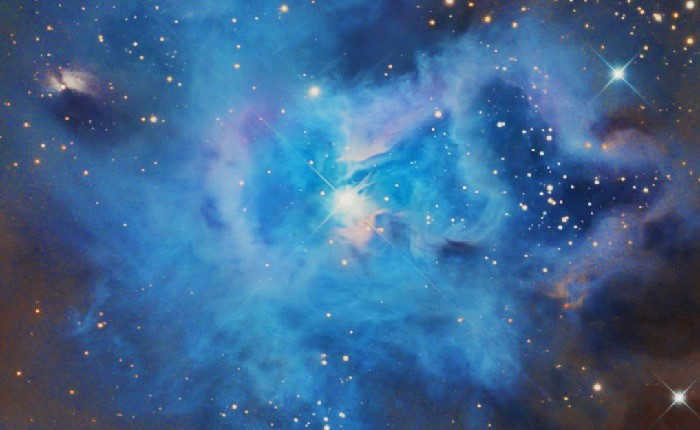

It is evident that the Cepheus constellation boasts a variety of fascinating entities. Unquestionably, each one possesses its own distinct beauty. This is likely what renders our Universe unfathomable. For everything within it is unparalleled and exceedingly enigmatic.
Observation
When searching for the constellation Cepheus, it is best to focus on the areas between Cassiopeia and the Little Bear. Astronomers suggest that late summer and early fall are the optimal times for visibility.
Due to its significant northern declination, Cepheus can be easily seen from all parts of Russia. This makes it particularly important for Russian observers.
Cepheus is a constellation located in the northern sky and is named after Cepheus, the king of Ethiopia in Greek mythology.
Cepheus was included in the list of 48 constellations by the astronomer Ptolemy in the 2nd century and continues to be one of the 88 constellations recognized today.
The Story and Legends
Cepheus, the ruler of Ethiopia, is a prominent figure in history and mythology. His marriage to Cassiopeia and his role as the father of Andromeda have forever immortalized him, with all three figures being honored as modern constellations.
A Glimpse into Cepheus
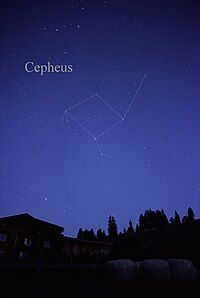
The constellation of Cepheus can be observed with the naked eye.
The brightest star in the constellation, known as Alpha Cepheus or Alderamin, has an apparent magnitude of 2.51. Delta Cephea, located 980 light-years away from Earth, is a yellow supergiant and the prototypical variable Cepheid. It was first discovered by John Goodricke in 1784. Its brightness fluctuates between 3.5 and 4.4 over a period of 5 days and 9 hours. Cepheids belong to a class of pulsating variable stars. Delta Cephei has a minimum size of 40 solar diameters and a maximum size of 46 solar diameters. Additionally, it is a double star, with a widely spaced blue-colored companion that has a magnitude of 6.3.
There are three red supergiants in the constellation that can be seen without any optical aids. Mu Cephei, also known as Herschel’s Garnet Star due to its deep red hue, is a star that varies in brightness. It has a low magnitude of 5.1 and a high magnitude of 3.4, with a cycle that lasts around 2 years. This star has a radius of approximately 5.64 astronomical units, which is equivalent to the distance from the Sun to Jupiter if it were placed at the center of our solar system. Another red supergiant in the constellation is VV Cephei A, which, like Mu Cephei, is a variable star. Located at a minimum distance of 5,000 light-years from Earth, VV Cephei A has a minimum magnitude of 5.4 and a maximum magnitude of 4.8. It is paired with a blue main-sequence star called VV Cephei B. VV Cephei A is one of the largest stars in our galaxy, with a diameter that is 1400 times larger than the Sun. This star is of particular interest as it is part of an eclipsing double system, with eclipses occurring every 20.3 years. However, these eclipses are too faint to be observed with the naked eye. Lastly, T. Cephei is another red giant in the constellation. It is a variable star known as a Myra, with a minimum magnitude of 11.3 and a maximum magnitude of 5.2. T. Cephei is located 685 light-years away from Earth and has a period of 13 months. Its diameter ranges between 329 and 500 times the diameter of the Sun.
Cepheus contains a number of prominent binary stars. Omicron Cepheus is a binary star system that has an orbital period of 800 years. This system is located 211 light-years away from Earth and is composed of a large orange star with a magnitude of 4.9 and a smaller secondary star with a magnitude of 7.1. Another binary star in Cepheus is Xi Cepheus, which is situated 102 light-years away from Earth and has an orbital period of 4,000 years. The primary star in this system has a blue-white color and a magnitude of 4.4, while the secondary star is yellow and has a magnitude of 6.5.
Kruger 60 is a double star with a magnitude of 11. It consists of two red dwarf stars and is one of the closest star systems to Earth, being only 13 light-years away.
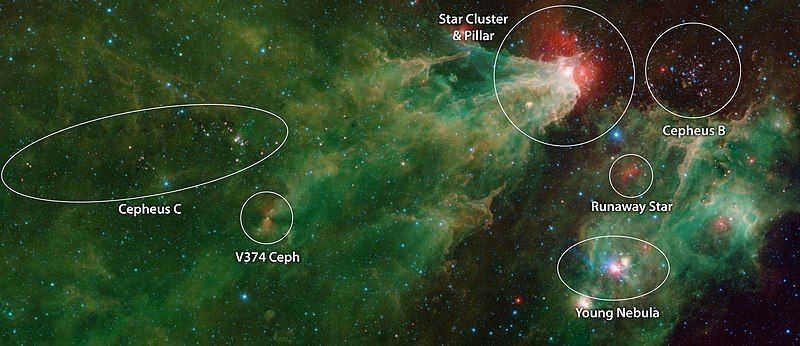
Spitzer Space Telescope captured the Cepheus C and B regions on May 30, 2019.
Astronomical Entities
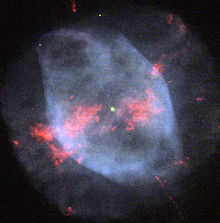
NGC 7354 is a celestial object known as a planetary nebula, which can be found in the constellation Cepheus.
- NGC 188 is a cluster of stars that is unique because it is the closest cluster to the North Pole of our planet. It is also one of the oldest clusters that has been discovered.
- NGC 6946 is a type of galaxy called a spiral galaxy. It is notable for having witnessed ten supernovae, making it the galaxy with the highest number of observed supernovae.
- – is another spiral galaxy that is characterized by its compact nucleus and oval shape. It also has prominent side arms.
- The nebula NGC 7538 is a fascinating location because it is home to the largest protostar that has been discovered so far.
- NGC 7023 is a nebula that reflects light from surrounding stars. It is associated with a star cluster and has a total magnitude of 7.7. This nebula is located 1,400 light-years away from Earth and can be found near the stars Beta Cephei and T Cephei.
- The Cave Nebula, also called S 155, is a faint and highly spread out bright nebula located within a larger nebula system, which includes radiation, reflection, and a dark nebula.
- Quasar6C B0014 + 8120 stands as one of the most formidable entities in the cosmos, fueled by a supermassive black hole that holds the mass of 40 billion suns.
Data Visualizations
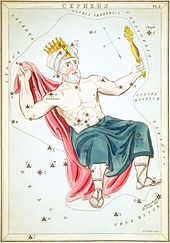
The constellation Cepheus is portrayed in The Mirror of Urania, a collection of star charts printed in London around 1825
Cepheus is commonly illustrated with his hands raised in prayer, beseeching the gods for the salvation of Andromeda’s life. Additionally, he is often depicted as a majestic ruler, seated upon a throne.
In Chinese astronomy, the stars of the Cepheus constellation are located in two areas: the Purple Forbidden Body (紫微 垣, Zǐ Wēi Yuán) and the Black Turtle of the North (北方 玄武, Běi Fāng Xuán Wǔ).
Relevance in Popular Culture
- The television sitcom 3rd Stone from the Sun claims that the aliens’ home planet is situated in a spiral galaxy with a junction at the border of Cepheus and Draco.
- One of the antagonists in the video game Mega Man Star Force goes by the name King Cepheus, which directly refers to the Cepheus constellation.
- The Canadian progressive-house producer Dedmau5 titled his instrumental track “HR 8938 Cephei” after a star in the Cepheus constellation.
- The final boss in the video game Lovers in Dangerous Space-Time is named King Cepheus as a tribute to the constellation.
- The character Major Roy McBride embarks on a journey to Neptune on a spaceship called Cepheus in the film Ad Astra.
The namesakes are.
The United States Navy ships, including USS Cepheus (AKA-18), are named after the constellation.
- USS Cepheus (AKA-18) is one of the United States Navy ships.
See also
References
- Levy, David H. (2005). Deep Sky objects. Prometheus Books. ISBN 1-59102-361-0. CS1 maint: ref = harv (link)
- Ridpath, Jan; Tirion, Wil (2001), Stars and Planets Guide, Princeton University Press, ISBN 0-691-08913-2
- Ian Ridpath and Wil Tirion (2007). Stars and Planets Guide, Collins, London. ISBN 978-0-00-725120-9. Princeton University Press, Princeton. ISBN 978-0-691-13556-4.
- Staal, Julius D.W.. (1988), New patterns in the sky: myths and legends of the stars (2nd ed.), McDonald and Woodward Publishing Company, ISBN 0-939923 -04-1
External references
| There is content about Cepheus (category) on Wikimedia Commons |
GPS coordinates: 22 00 00, + 70° 00 ′ 00″
How can you locate the constellation Cepheus in the night sky?
Among the various constellations visible throughout the year, such as the Big Dipper, Little Dipper, Cassiopeia, Giraffe, Lynx, and Dragon, Cepheus stands out as a perennial favorite. These constellations are known as near-polar constellations or near-polar, as they are positioned close to the celestial pole and Polaris. However, this doesn’t imply that the constellation remains fixed in the same spot in the sky at all times, unlike Polaris. Instead, it traces daily circles in the sky, mirroring the Earth’s rotation on its axis.
Thus, the position of the constellation Cepheus can vary depending on the time of year and the time of day. It can be observed low above the horizon in the north, then in the east, and eventually almost in the zenith. It is important to keep this in mind for those who are unsure of how to navigate the starry sky.
If you want to find the constellation Cepheus, there are a few simple steps you can follow:
- Be familiar with the appearance and basic pattern of the constellation Cepheus.
- Know the general location of the constellation in the sky, between which prominent stars it is situated. This will help you quickly identify the search area.
Drawing of the constellation Cepheus
A lot of beginner stargazers learn about constellations not by individual stars, but by familiarizing themselves with the main visual patterns of the constellations (if they have any). Cepheus has such a pattern – it resembles a house made up of five stars.
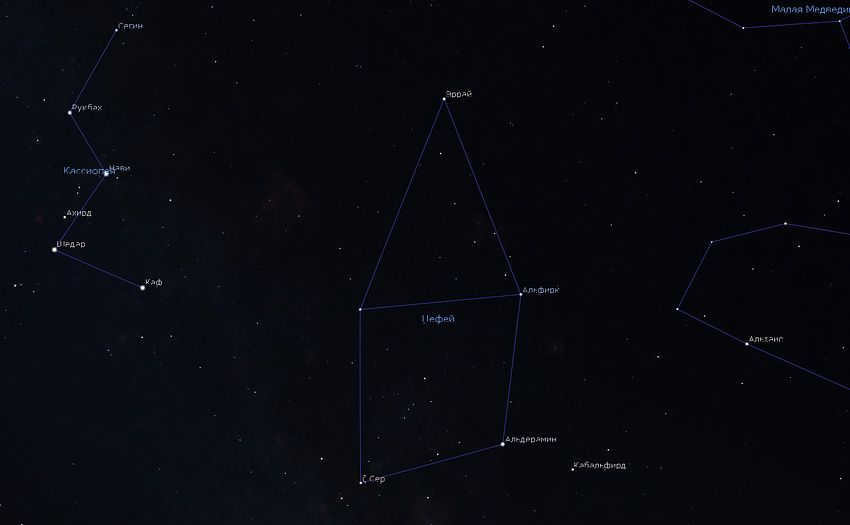
The depiction of the Cepheus constellation bears a resemblance to a quaint house with a triangular rooftop or a child’s rendition of a rocket. Illustration: Stellarium
Undoubtedly, this peculiar house is rather small and features a sharply-pointed roof! It is the type of structure that is typically sketched by young children.
All it takes is one sighting of this architectural formation in the night sky, and voila, you have mastered the art of sketching a constellation!
However, the location of “Cepheus’ house” is still a mystery. Here are the notable points of reference:
- The Swan constellation and its brightest star, Deneb. The Swan is characterized by a large cross shape, and Deneb is part of the Summer Triangle!
- The Cassiopeia constellation, which is familiar to many. It resembles either the letter W or the inverted letter M in shape.
- Polaris, a well-known star that requires no introduction.
The area of the sky containing the lodge can be found within the triangle formed by these three celestial objects – Deneb, Cassiopeia, and Polaris.
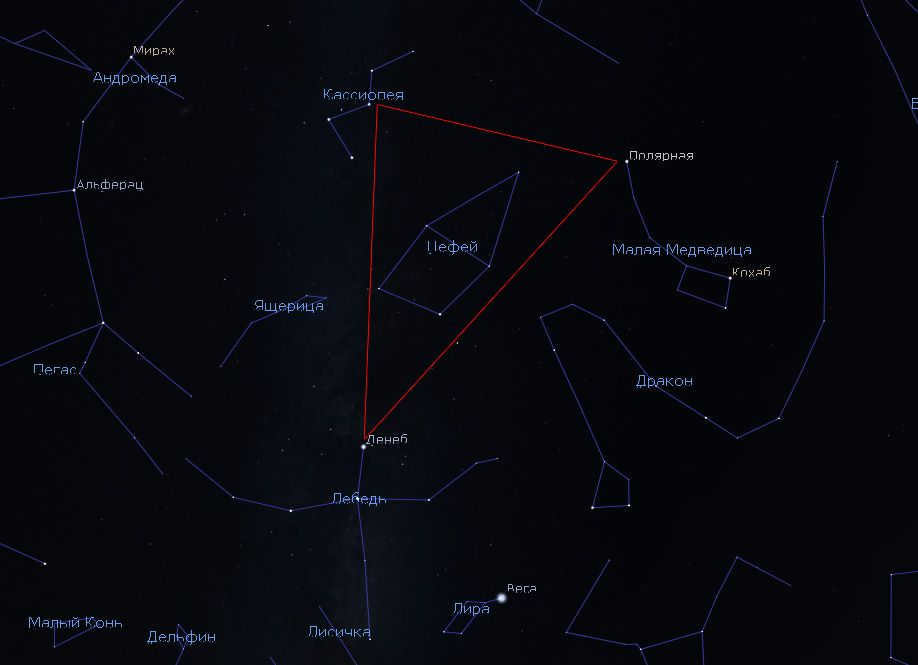
Cepheus, the constellation, can be found in the area of the sky that lies between Polaris, Deneb, and Cassiopeia. This region is known for its dim stars, which can be easily seen in rural areas like villages or cottages. However, in urban environments, especially in large cities, locating Cepheus in the sky can be quite challenging. Unless you live in the outskirts, you will need to find a dark location away from streetlights and observe during a time when the atmosphere is clear and dark, free from smog, peripheral clouds, and a bright Moon.
Cepheus constellation at different times throughout the year
We previously mentioned three reference points for locating the Cepheus constellation – Deneb, the Cassiopeia constellation, and Polaris. It is worth noting that Polaris remains fixed in the sky, while all other stars and constellations revolve around it. This means that one of the reference points is always stationary, while the other two – the star Deneb and Cassiopeia – orbit around Polaris.
The Cepheus constellation itself also undergoes rotation. It is most ideal to observe Cepheus when it is positioned high in the sky, and least favorable when it begins to descend towards the horizon. So, when exactly does this occur?
If we assume that our observation takes place in the evening, a few hours after sunset, then the Cepheus constellation will be situated in the spring when it is at the horizon.

The constellation Cepheus can be observed in the northern part of the sky, below Polaris, during the spring evenings. This celestial formation can also be seen quite high in the east during the summer months. As the seasons progress, Cepheus reaches its highest point, or zenith, in late summer and fall. In the winter, it can be found in the western part of the sky, where the sun sets.
| Time of day. | Autumn. | Winter | Spring | Summer |
| Evening | southeast | west | north | northeast |
| Night | zenith | northwest | northeast | east |
| Morning | northwest | north | northeast | southeast |
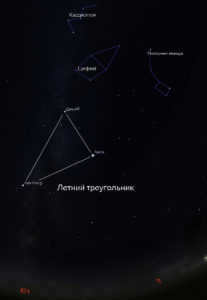
In the autumn season, Cepheus reaches its highest point in the sky, positioned to the left of the Summer Triangle. See the image: Stellarium
What is the optimal time to observe the constellation Cepheus?
It appears that the ideal time to observe Cepheus is during the summer and winter months. (During this period, there is no need to strain your neck to catch a glimpse of the constellation). However, it is important to consider that during the summer in most parts of Russia, the nights are short and bright. This makes it challenging to discern the faint stars during this time. In the winter, additional difficulties arise due to freezing temperatures and frequent cloud cover.





